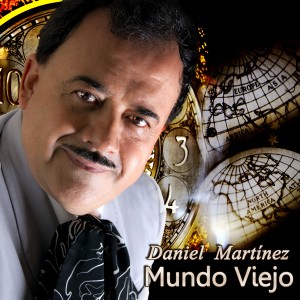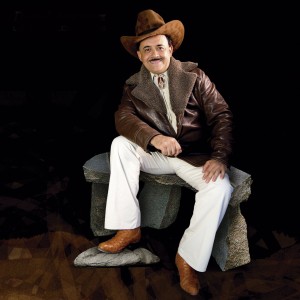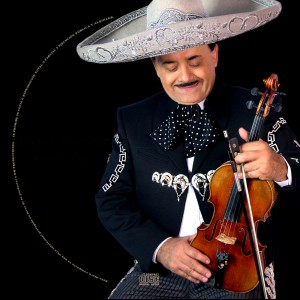Just in time for last December’s Mariachi Vargas Extravaganza, Daniel Martínez, longtime member of Mariachi Vargas de Tecalitlán, released his first solo CD, titled Mundo Viejo and subtitled De México Para el Mundo… Un Nuevo Compositor, in which he is featured as vocal soloist and author of all compositions. In this article, Jonathan Clark interviews Daniel about his latest release, a CD that should be of interest to all fans of mariachi music.
JC: Many years ago, Daniel, when I first met you, you hadn’t yet started writing songs. How did this phase of your career come about?
DM: My wife Gloria is the muse responsible for the discovery of this hidden talent. One day, I was writing some verses and she asked, “Why don’t you write a song dedicated to me?” Well, I did, and that’s how it all started. Once I’d written the first one, the rest just started pouring out. Right now, I have nearly 100 original compositions. Some are better than others, of course.
JC: That’s simply amazing! So once you wrote the first song, the fountain of inspiration just kept flowing.
DM: I wrote that first song back in 2008. I was 51 years old and had been a Mariachi Vargas member for 22 years. Now I’m 57 and have been with the group for 29 years.
JC: So, describe for me how your compositional process works.
DM: First, to create good material, the inspiration has to come. Sometimes this happens when we’re on tour riding in the bus. Sometimes it happens in an airplane, and it’s even happened in the shower! (laughs) There have been times when a song comes to me in a dream, and I get up and write it down before I forget it. The words and melody usually come to me at the same time. I always try to carry some kind of recording device with me, whether it be a cell phone or an iPod, so I won’t forget an important idea. At home, I harmonize the song on the guitar and make a reference recording of it — sort of a rough arrangement —then I go and copyright it. But don’t think the ideas for these songs come to me in finished form. Normally it takes a tremendous amount of revision and polishing to get them to where I want them.
JC: Did you ever study composition formally?
DM: No, it’s just an ability that came to me naturally, although I’ve had a lot of help from people much more knowledgeable than me, like maestros Rubén Fuentes, Jesús Rodríguez de Híjar and Pepe Martínez. Certain things about rhyme schemes were unclear to me. I’d been told, for example, that it was mandatory for stanzas to be comprised of symmetrical lines, each with an identical number of syllables, in accordance with the established rules of poetry. Maestro Fuentes, on the other hand, taught me how some of the best canciones rancheras contain discrepancies of this nature, and how it’s valid to break those rules, as long as you do it with purpose and musicality.
JC: What are your most important musical influences?
DM: In the first place, Mexican music; above all, mariachi music. I also like norteño, huasteco, and other regional styles, not to mention the great romantic trios. I like Venezuelan folk music, American dance orchestras, and jazz as well. I’m not too fond of contemporary banda music, or rock. I love classical music and Italian opera, even though I don’t understand the language. In fact, my daughter Rocío Berenice is a soprano and she recently graduated from the Escuela Superior de Música with a degree in opera.
Keep in mind, Jonny, that no song is entirely original; we’re all influenced by various sources, some of which are subliminal. At the same time, I consciously try to avoid coming up with songs that sound like somebody else’s.
JC: This is your first solo CD, but not the first time your songs have been recorded, correct?
DM: That’s right. The first recording was in 2009, on the Mariachi Vargas CD La Inspiración de Sus Integrantes, on which I was fortunate enough to have three of my songs featured. One of them was a collaboration with my compadre Pepe Martínez. That inspired me to keep writing, with the intention of someday making an album of my own.
JC: Out of all the original songs you have stockpiled, how did you select the 14 that make up this CD?
DM: First of all, I tried to pick out the songs that would best capture the public’s interest. If you write a song that’s too personal, most people won’t identify with it. I tried to pick songs that talk about everyday life — the collective human experience — and I tried to mix up the genres and tempos as much as possible, to come up with a varied playlist.
JC: I imagine you would have preferred to record the whole CD with the accompaniment of Mariachi Vargas.
DM: Of course. But for economic reasons, since I financed this production myself, I ended up recording it in Guadalajara. Several compañeros from Mariachi Vargas participated, and they didn’t charge me a cent. The studio where we recorded it belongs to Miguel Angel Barrón “el Gigio,” who, incidentally, overdubbed all the rhythm section parts himself. I think the production turned out to be of high quality.
JC: You do a great job as vocal soloist on the entire disc, and I noticed the countertenor voices on the refrains of certain songs are also quite outstanding.
DM: Actually, two different singers contributed those countertenor parts (see individual song comments below for details). That’s something that was unfortunately overlooked on the printed CD credits. If you listen carefully, it’s easy to tell who’s who. One is my former compañero Steeven Sandoval. What can I say about Steeven? His is simply one of the greatest voices in mariachi music. The other is my compañero Fernando Velásquez “el Tomatón,” who’s best known for his trumpet skills. Steeven has a more trained voice, whereas Fernando’s is more natural. In the vernacular, we call it a “voz cuamielera,” referring to aguamiel, the sweet nectar of the maguey cactus. It’s a countrified type of voice that people from rural areas tend to prefer. My intention in those parts was to recreate the sound of the great duetos rancheros of yesteryear, duets like Los Dos Reales, Los Dos Oros, Dueto Miseria; Dueto Azteca, Dueto Amanecer; Hermanas Padilla, Hermanas Huerta, Las Palomas, and others like that.
JC: I notice that Javier Carrillo did the majority of the arrangements.
DM: He’s been a good friend for many years, and I really like the way he writes. Not all great arrangers are as accessible as he is, and we work well as a team. Javier took all my ideas into account and made the arrangements exactly how I wanted them. Also, my compadre Pepe Martínez and my compañero Miguel “el Gigio” each wrote two arrangements for this album, which are excellent as well.
JC: What were your objectives in making this CD?
DM: My intention was to leave a legacy for my fellow musicians — an album I could be proud of — so that someday when I’m no longer here, they’d have something to remember me by. It would give me great satisfaction if this disc is played and these songs are performed by others. One of my dreams is that major artists will record my songs. My compañero Arturo Vargas already recorded “Alcanzando Una Estrella,” and Octavio Moreno of the Houston Grand Opera recorded “La Gitanilla” and “Sobraron las Palabras.” It’s not an easy task to promote this material, but I’m knocking on doors!
JC: One last question: Over the years, there have been several Mariachi Vargas members by the last name of Martínez. Many people assume that you’re related to some of these luminaries.
DM: It would be an honor if I were, but it’s just a coincidence we have the same last names. We come from different bloodlines.
JC: Well, Daniel, congratulations on this important accomplishment. We all wish you great success in this new phase of your musical career.
DM: Thank you very much!
JC: Where can our readers get Mundo Viejo?
DM: They can download the album on iTunes, Amazon.com and other online sources, and they can purchase the CD at any Mariachi Vargas concert, or by mail from sandra@munozpublicrelations.com.
Daniel’s comments on the songs
1. I chose “Mundo Viejo” the title track for this CD. The name is a metaphor for the mysteries of life and the planet we live on. A lot of scientists speculate on the age of our planet, but that’s something only the Creator could know. We tend to define “old” and “new” in terms of our own lifespan, when in reality we’ll all turn to dust as the world continues its perpetual renewal. In this huapango, a pair of flutes compliment the basic mariachi accompaniment.
2. “Gitanilla” is about a gypsy woman, the kind who reads your palm and tells your fortune. When you’re in love, you might go to one of these ladies to get relationship advice. Deep down, you know she’s a charlatan, but she tells you things you want to hear and in your euphoric state of mind, you believe her. But after the love affair turns sour, you realize her advice was worthless. Flamenco guitar and cello augment the mariachi in this Andalucian-style song.
3. “Sobraron Las Palabras” is about the times when your lover is upset with you. She reprimands you, but you approach her tenderly and whisper sweet words into her ear. Her anger begins to fade, and you kiss tenderly. A requinto compliments this romantic canción ranchera.
4. When I was young, every time I’d pass by the house of a certain girl, I would sigh, dreaming that someday she would become my novia. My heart would almost pound out of my chest! “Un Suspirito” is a ranchera I wrote reminiscing on those youthful passions of my first loves. The countertenor voice is that of Fernando Velásquez. Having been born in Coahuila, I’m a Norteño myself, and I added an accordion to give this arrangement the regional flavor of my homeland.
5. “La Cantina” is another autobiographical song of mine. How many of us have gone into a cantina and drunk more than we should have, trying to drown the sorrow of a broken heart? This canción ranchera starts out with the intimate accompaniment of harp and guitar, and eventually the whole mariachi comes in. Steeven Sandoval sings in duet with me.
6. “El Río Bravo” is about a topic that millions of Mexicanos constantly carry in our subconscious, and one that’s in the news almost every day. How many have been lured by the American Dream, believing that the streets were paved with dollars, only to tragically lose their lives crossing the river that separates our two countries? Fernando Velásquez sings the countertenor part on this corrido norteño, and the addition of an accordion gives it a distinct a border flavor.
7. On one of my many trips to Puerto Rico with Mariachi Vargas, our plane descended on that island just after sunset. In spectacular fashion, the stars reflected off the ocean’s mirror-like surface. At that moment, the line “Puerto Rico, veil of silver,” came to me, and I began writing “Puerto Rico, Isla Caribeña,” dedicated to that Caribbean paradise. It seemed only natural to add percussion instruments to this tropical bolero. The vocal trio in the chorus features the voices of Fernando Velásquez (1st), Andrés González (2nd), and Miguel Barrón (3rd).
8. “Perla Tapatía” is dedicated to Guadalajara, and it expresses the esteem I have for that city and for the state of Jalisco. The idea came from fellow group member Andrés González, and I wrote it my hotel room while we were performing at Guadalajara’s Encuentro Internacional del Mariachi. It’s a hybrid son-canción, in the spirit of songwriters like Pepe Guízar and Manuel Esperón. The chorus features the same trio of voices as the previous song.
9. “Me Voy Lejos” is a traditional canción ranchera I wrote on a bus while touring California with Mariachi Vargas. It’s a classic breakup song, with a universal theme: “I’m going far away, where I’ll never hear your name again and where you can’t watch me suffer.”
10. “El Hijo del Huapanguero” was conceived as a sequel and tribute to the famous huapango “Rogaciano el Huapanguero.” Sones and huapangos happen to be two of my favorite genres. Unfortunately, few composers write in these styles nowadays. One of my intentions here was to convey the message that contemporary performers and songwriters shouldn’t neglect the traditional genres that form the foundation of our mariachi repertoire. A pair of flutes completes the orchestration.
11. In contrast to the narcocorridos so much in vogue these days, “Cuatro Velas y un Cajón” (“El Vicio Me Acabó”) is a stern warning against the destructive consequences of drugs and alcohol. In addition to an accordion, this corrido features Steeven Sandoval on the high voice.
12. “El Nogal” evokes nostalgia of my early childhood on the ranch, when my grandmother used to sit me down under the shade of a walnut tree. For this song I used a romantic, early 20th century canción mexicana setting, in the style of Manuel M. Ponce. The rhythm is a danza, one that’s seldom used today. The instrumentation includes cello, flutes, and oboe.
13. “Cantinero” is a ranchera thematically similar to “La Cantina.” Both are songs of catharsis through alcohol, in the tradition of immortal songwriter José Alfredo Jiménez, whom I have always admired. Fernando Velásquez contributes the high voice.
14. “Nidito de Amor” is a romantic-themed huapango that anyone who’s ever been in love should be able to relate to. As I mentioned, I have a special fondness for huapangos.









Hola.
Desde lo lanzamiento de ese CD he intentado comprarlo en Guadalajara, Cd. México, Puebla y otros llugares pero no he logrado éxito.
Tenia todas las canciones en el Spotify, pero perdi los archivos y ahora me gustaria saber en donde encontrar ese CD para comprarlo.
Gracias.